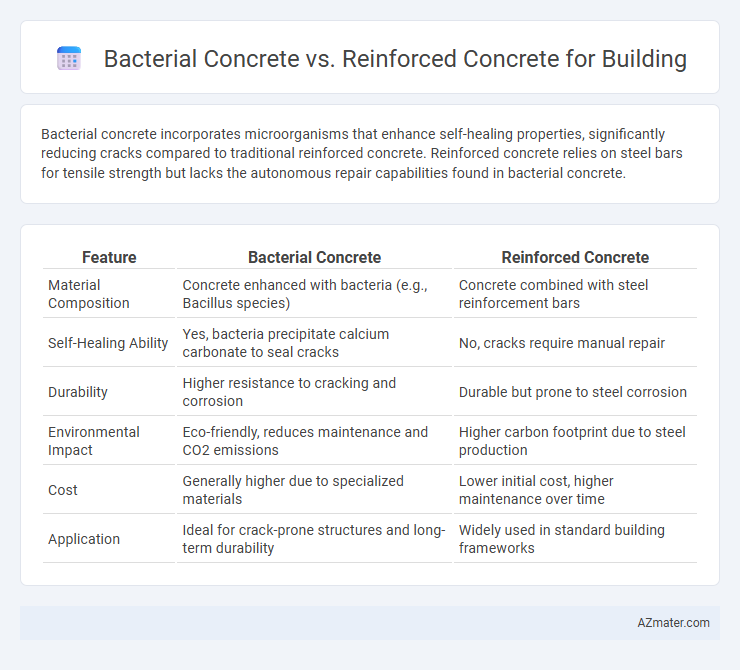Bacterial concrete incorporates microorganisms that enhance self-healing properties, significantly reducing cracks compared to traditional reinforced concrete. Reinforced concrete relies on steel bars for tensile strength but lacks the autonomous repair capabilities found in bacterial concrete.
Table of Comparison
| Feature | Bacterial Concrete | Reinforced Concrete |
|---|---|---|
| Material Composition | Concrete enhanced with bacteria (e.g., Bacillus species) | Concrete combined with steel reinforcement bars |
| Self-Healing Ability | Yes, bacteria precipitate calcium carbonate to seal cracks | No, cracks require manual repair |
| Durability | Higher resistance to cracking and corrosion | Durable but prone to steel corrosion |
| Environmental Impact | Eco-friendly, reduces maintenance and CO2 emissions | Higher carbon footprint due to steel production |
| Cost | Generally higher due to specialized materials | Lower initial cost, higher maintenance over time |
| Application | Ideal for crack-prone structures and long-term durability | Widely used in standard building frameworks |
Introduction to Bacterial Concrete and Reinforced Concrete
Bacterial concrete incorporates specialized bacteria that precipitate calcium carbonate, enhancing self-healing properties and increasing durability by sealing micro-cracks automatically. Reinforced concrete consists of concrete embedded with steel bars or mesh, providing tensile strength to withstand structural loads and resist cracking under tension. Both materials serve critical roles in construction, with bacterial concrete offering innovative maintenance benefits and reinforced concrete ensuring foundational strength.
Composition and Materials Used
Bacterial concrete incorporates specific strains of bacteria such as *Bacillus pasteurii* within the traditional cement matrix, enabling bio-mineralization that enhances crack healing and durability, contrasting with reinforced concrete which primarily consists of cement, aggregates, water, and steel reinforcement bars designed to bear tensile loads. The bacterial concrete matrix often includes calcium lactate as a nutrient source for bacterial activity, promoting calcium carbonate precipitation that fills micro-cracks, while reinforced concrete relies on the mechanical strength of embedded steel to resist tensile stresses and structural loads. Bacterial concrete offers self-healing properties and improved sustainability by reducing maintenance and increasing lifespan, whereas reinforced concrete depends on reinforcing bar corrosion protection and concrete quality for durability.
Mechanism of Strength Development
Bacterial concrete develops strength through microbial-induced calcite precipitation, where bacteria such as Bacillus pasteurii produce calcium carbonate that fills cracks and pores, enhancing durability and compressive strength. Reinforced concrete gains strength primarily from the combination of concrete's compressive capacity and steel reinforcement's tensile strength, creating a composite material capable of withstanding various loads. The bio-mineralization process in bacterial concrete offers autonomous crack healing and improved longevity, contrasting with the mechanical load distribution mechanism in reinforced concrete.
Durability and Lifespan Comparison
Bacterial concrete exhibits enhanced durability by self-healing micro-cracks through bacterial-induced calcite precipitation, significantly increasing its lifespan compared to traditional reinforced concrete. Reinforced concrete typically lasts 50-100 years but is prone to corrosion and cracking, whereas bacterial concrete can extend structural longevity beyond 120 years by reducing permeability and preventing crack propagation. These properties make bacterial concrete a sustainable alternative for long-term infrastructure with improved resistance to environmental degradation.
Crack Healing Ability
Bacterial concrete utilizes specific bacteria such as Bacillus pasteurii to precipitate calcium carbonate, effectively sealing cracks autonomously and enhancing durability. Reinforced concrete depends on steel reinforcements to prevent structural failure but lacks inherent self-healing properties for crack repair. The self-healing ability of bacterial concrete significantly reduces maintenance costs and extends the lifespan of buildings compared to traditional reinforced concrete.
Environmental Impact and Sustainability
Bacterial concrete utilizes microbial-induced calcite precipitation to self-heal cracks, significantly reducing maintenance and extending the lifespan of structures, leading to lower environmental impact compared to reinforced concrete that relies on steel reinforcement with high carbon emissions during production. The use of bacteria in concrete decreases the need for frequent repairs, minimizing resource consumption and waste generation, enhancing overall sustainability in construction projects. Reinforced concrete's dependence on cement and steel contributes to substantial greenhouse gas emissions, making bacterial concrete a more eco-friendly alternative for green building initiatives.
Cost Analysis and Economic Feasibility
Bacterial concrete reduces long-term maintenance costs by self-healing microcracks, extending structural lifespan and minimizing repair expenses compared to reinforced concrete. Although initial construction costs for bacterial concrete are higher due to specialized materials and bio-additives, its economic feasibility improves through lifecycle savings and sustainability benefits. Reinforced concrete offers lower upfront expenses but may incur significant costs over time from deterioration and increased maintenance requirements in harsh environments.
Structural Performance and Load-Bearing Capacity
Bacterial concrete enhances structural performance by self-healing microcracks through microbial-induced calcite precipitation, reducing maintenance and increasing durability compared to traditional reinforced concrete. Reinforced concrete relies on steel reinforcement for load-bearing capacity, providing high tensile strength, while bacterial concrete can improve compressive strength and extend service life by minimizing crack propagation. Incorporating bacterial agents into concrete mixtures results in superior resistance to environmental degradation, contributing to sustained load-bearing capacity and improved structural integrity over time.
Applications in Modern Construction
Bacterial concrete enhances durability by self-healing microcracks through calcite precipitation, significantly reducing maintenance costs in modern construction applications like bridges, tunnels, and high-rise buildings. Reinforced concrete remains a staple for structural integrity, providing tensile strength with embedded steel bars, widely used in foundations, beams, and columns across residential and commercial projects. Combining bacterial concrete with traditional reinforcement techniques optimizes lifespan and sustainability, supporting eco-friendly building practices in urban infrastructure development.
Future Prospects and Research Trends
Bacterial concrete, integrating microbial-induced calcite precipitation, shows significant potential for self-healing capabilities and enhanced durability compared to traditional reinforced concrete, addressing cracking and longevity challenges. Research trends emphasize optimizing bacterial strains, nutrient delivery systems, and environmental impact assessments to increase scalability and cost-effectiveness for sustainable construction. Future prospects suggest widespread adoption of bacterial concrete in infrastructure resilience, reducing maintenance costs and carbon footprint in urban development projects.

Infographic: Bacterial concrete vs Reinforced concrete for Building
 azmater.com
azmater.com